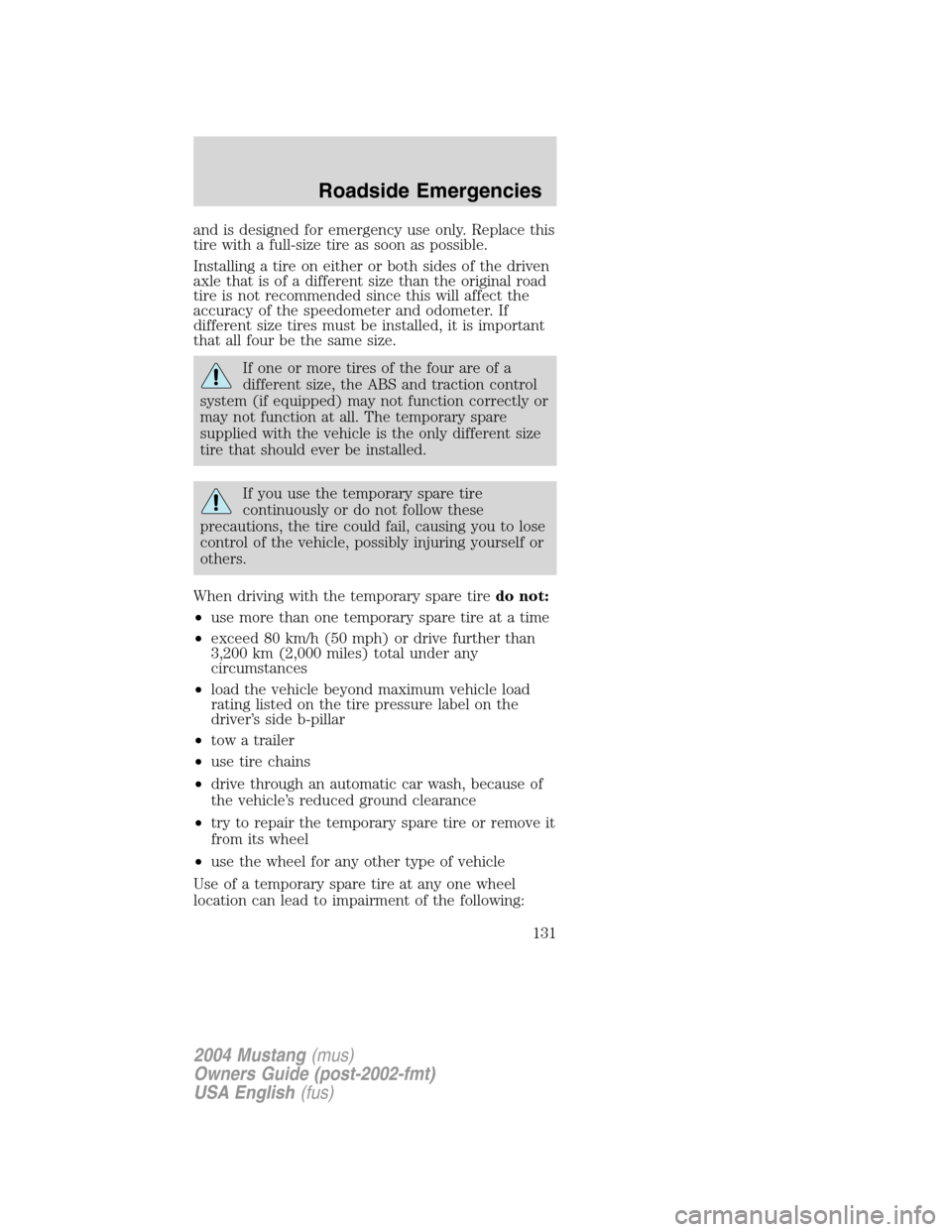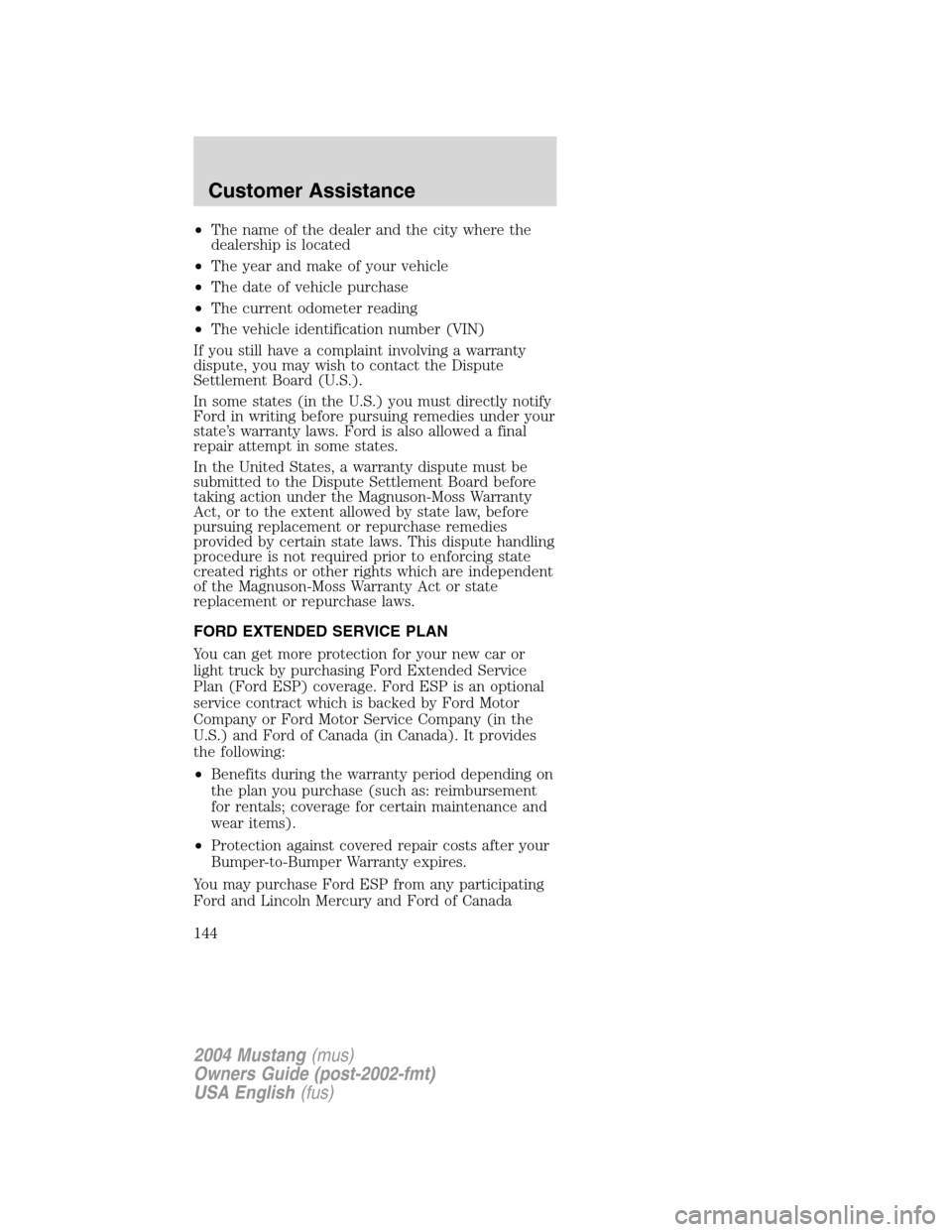Page 15 of 240
•Optional instrument
cluster
•Mach 1 instrument
cluster
Engine coolant
temperature gauge:
Indicates engine
coolant temperature. At
normal operating temperature, the needle will be in
the normal range (between“H”and“C”). If it enters
the red section, the engine is overheating. Stop the
vehicle as soon as safely possible, switch off the
engine and let the engine cool.
Never remove the coolant reservoir cap
while the engine is running or hot.
Odometer:Registers
the total kilometers
(miles) of the vehicle.
Trip odometer:
Registers the
kilometers (miles) of
individual journeys.
Press and release the
reset button until a“T”
appears in the display.
Press and hold the button for three seconds to reset.
CH
0
00000 00
4
5
6
7
8 3
2
1RPMX1000
SELECT/RESET
.
2004 Mustang(mus)
Owners Guide (post-2002-fmt)
USA English(fus)
Instrument Cluster
15
Page 131 of 240

and is designed for emergency use only. Replace this
tire with a full-size tire as soon as possible.
Installing a tire on either or both sides of the driven
axle that is of a different size than the original road
tire is not recommended since this will affect the
accuracy of the speedometer and odometer. If
different size tires must be installed, it is important
that all four be the same size.
If one or more tires of the four are of a
different size, the ABS and traction control
system (if equipped) may not function correctly or
may not function at all. The temporary spare
supplied with the vehicle is the only different size
tire that should ever be installed.
If you use the temporary spare tire
continuously or do not follow these
precautions, the tire could fail, causing you to lose
control of the vehicle, possibly injuring yourself or
others.
When driving with the temporary spare tire do not:
• use more than one temporary spare tire at a time
• exceed 80 km/h (50 mph) or drive further than
3,200 km (2,000 miles) total under any
circumstances
• load the vehicle beyond maximum vehicle load
rating listed on the tire pressure label on the
driver’s side b-pillar
• tow a trailer
• use tire chains
• drive through an automatic car wash, because of
the vehicle’s reduced ground clearance
• try to repair the temporary spare tire or remove it
from its wheel
• use the wheel for any other type of vehicle
Use of a temporary spare tire at any one wheel
location can lead to impairment of the following:
2004 Mustang (mus)
Owners Guide (post-2002-fmt)
USA English (fus)
Roadside Emergencies
131
Page 144 of 240

•The name of the dealer and the city where the
dealership is located
•The year and make of your vehicle
•The date of vehicle purchase
•The current odometer reading
•The vehicle identification number (VIN)
If you still have a complaint involving a warranty
dispute, you may wish to contact the Dispute
Settlement Board (U.S.).
In some states (in the U.S.) you must directly notify
Ford in writing before pursuing remedies under your
state’s warranty laws. Ford is also allowed a final
repair attempt in some states.
In the United States, a warranty dispute must be
submitted to the Dispute Settlement Board before
taking action under the Magnuson-Moss Warranty
Act, or to the extent allowed by state law, before
pursuing replacement or repurchase remedies
provided by certain state laws. This dispute handling
procedure is not required prior to enforcing state
created rights or other rights which are independent
of the Magnuson-Moss Warranty Act or state
replacement or repurchase laws.
FORD EXTENDED SERVICE PLAN
You can get more protection for your new car or
light truck by purchasing Ford Extended Service
Plan (Ford ESP) coverage. Ford ESP is an optional
service contract which is backed by Ford Motor
Company or Ford Motor Service Company (in the
U.S.) and Ford of Canada (in Canada). It provides
the following:
•Benefits during the warranty period depending on
the plan you purchase (such as: reimbursement
for rentals; coverage for certain maintenance and
wear items).
•Protection against covered repair costs after your
Bumper-to-Bumper Warranty expires.
You may purchase Ford ESP from any participating
Ford and Lincoln Mercury and Ford of Canada
2004 Mustang(mus)
Owners Guide (post-2002-fmt)
USA English(fus)
Customer Assistance
144
Page 189 of 240

Calculating fuel economy
1. Fill the fuel tank completely and record the initial
odometer reading (in kilometers or miles).
2. Each time you fill the tank, record the amount of
fuel added (in liters or gallons).
3. After at least three to five tank fill-ups, fill the
fuel tank and record the current odometer reading.
4. Subtract your initial odometer reading from the
current odometer reading.
5. Follow one of the simple calculations in order to
determine fuel economy:
Calculation 1:Multiply liters used by 100, then
divide by total kilometers traveled.
Calculation 2:Divide total miles traveled by
total gallons used.
Keep a record for at least one month and record the
type of driving (city or highway). This will provide
an accurate estimate of the vehicle’s fuel economy
under current driving conditions. Additionally,
keeping records during summer and winter will show
how temperature impacts fuel economy. In general,
lower temperatures give lower fuel economy.
Driving style—good driving and fuel economy
habits
Give consideration to the lists that follow and you
may be able to change a number of variables and
improve your fuel economy.
Habits
•Smooth, moderate operation can yield up to 10%
savings in fuel.
•Steady speeds without stopping will usually give
the best fuel economy.
•Idling for long periods of time (greater than one
minute) may waste fuel.
•Anticipate stopping; slowing down may eliminate
the need to stop.
2004 Mustang(mus)
Owners Guide (post-2002-fmt)
USA English(fus)
Maintenance and Specifications
189